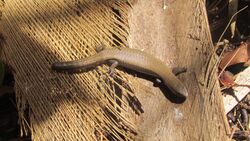Biology:Gymnophthalmus underwoodi
| Gymnophthalmus underwoodi | |
|---|---|

| |
| Underwood's spectacled tegu | |
| Scientific classification | |
| Domain: | Eukaryota |
| Kingdom: | Animalia |
| Phylum: | Chordata |
| Class: | Reptilia |
| Order: | Squamata |
| Family: | Gymnophthalmidae |
| Genus: | Gymnophthalmus |
| Species: | G. underwoodi
|
| Binomial name | |
| Gymnophthalmus underwoodi Grant, 1958
| |
Gymnophthalmus underwoodi, called commonly Underwood's spectacled tegu, is a species of microteiid lizard, which is found in South America and on certain Caribbean islands.
Etymology
G. underwoodi is named after British herpetologist Garth Leon Underwood.[2]
Reproduction
G. underwoodi is a unisexual species, reproducing through parthenogenesis. Captive specimens have been recorded laying up to eleven eggs within four months, with between one and four eggs per clutch.
Geographic range
The geographic distribution of G. underwoodi includes the islands of Guadeloupe, Martinique, Saint Vincent and the Grenadines, Barbados, Antigua, Barbuda, Trinidad, and Tobago in the Lesser Antilles; and Guyana, Suriname, Colombia, and Venezuela in South America. It is also present on Dominica, which has been confirmed by both Breuil (2002) and Turk et al. (2010). Recent incursions on Saba and Sint Eustatius have led to a widely occurring non-native populations on both islands.[3][4]
Habitat
The preferred natural habitat of G. underwoodi is grassland.[1]
Sources
- Breuil M (2002). Histoire naturelle des amphibiens et reptiles terrestres de l'Archipel Guadeloupéen. Guadeloupe, Saint-Martin, Saint-Barthélem. 54. Paris: Patrimoines Naturels. pp. 1–339.
- Malhotra, Anita; Thorpe, Roger S. (1999). Reptiles & Amphibians of the Eastern Caribbean. London: Macmillan Education Ltd.. pp. 34, 70, 83–84, 97, 101, 104. ISBN 0-333-69141-5.
References
- ↑ 1.0 1.1 Ouboter, P.; Doan, T.; Dewynter, M.; Thomas, R.; Powell, R. (2016). "Gymnophthalmus underwoodi". IUCN Red List of Threatened Species 2016: e.T178225A66749306. doi:10.2305/IUCN.UK.2016-3.RLTS.T178225A66749306.en. https://www.iucnredlist.org/species/178225/66749306. Retrieved 18 November 2021.
- ↑ Beolens, Bo; Watkins, Michael; Grayson, Michael (2011). The Eponym Dictionary of Reptiles. Baltimore: Johns Hopkins University Press. xiii + 296 pp. ISBN:978-1-4214-0135-5. (Gymnophthalmus underwoodi, p. 270).
- ↑ van den Burg, Matthijs P.; Hylkema, Alwin; Debrot, Adolphe O. (21 September 2021). "Establishment of two nonnative parthenogenetic reptiles on Saba, Dutch Caribbean: Gymnophthalmus underwoodi and Indotyphlops braminus". Caribbean Herpetology: 1–5. doi:10.31611/ch.79.
- ↑ Thibaudier, Julian; van den Burg, Matthijs P.; Mitchell, Adam; Cornwell, Tomas (2023-01-31). "Establishment of the Smooth-scaled Tegulet (Gymnophthalmus underwoodi) and the Common House Gecko (Hemidactylus frenatus) on St. Eustatius". Caribbean Herpetology: 1–6. doi:10.31611/ch.86. ISSN 2333-2468. https://doi.org/10.31611/ch.86.
External links
- Gymnophthalmus underwoodi at the Encyclopedia of Life.
- Gymnophthalmus underwoodi at the Reptile Database.
Further reading
- Grant C (1958). "A New Gymnophthalmus (Reptilia, Teiidae) from Barbados, B.W.I." Herpetologica 14 (4): 227–228. (Gymnophthalmus underwoodi, new species).
- Schwartz A, Henderson RW (1991). Amphibians and Reptiles of the West Indies: Descriptions, Distributions, and Natural History. Gainesville: University of Florida Press. 720 pp. ISBN:978-0813010496. (Gymnophthalmus underwoodi, p. 411).
- Schwartz A, Thomas R (1975). A Check-list of West Indian Amphibians and Reptiles. Carnegie Museum of Natural History Special Publication No. 1. Pittsburgh, Pennsylvania: Carnegie Museum of Natural History. 216 pp. (Gymnophthalmus underwoodi, pp. 123–124).
- Turk PA, Wyszynski NN, Powell R, Henderson RW (2010). "Population densities and water-loss rates of Gymnophthalmus pleii, Gymnophthalmus underwoodi (Gymnophthalmidae), and Sphaerodactylus fantasticus fuga (Sphaerodactylidae) on Dominica, West Indies". Salamandra 46 (3): 125–130.
- Williamson KE, Powell R (2004). "Gymnophthalmus underwoodii ". Catalogue of American Amphibians and Reptiles (793): 1–5.
Wikidata ☰ Q3013464 entry
 |


